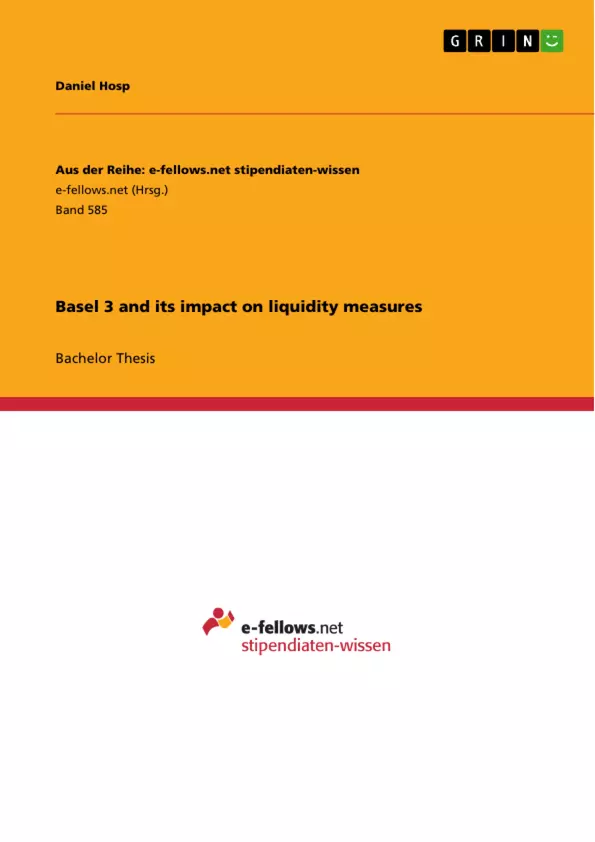1. Introduction
On 6 September 2009 the Central Bank Governors and Heads of Supervision agreed on Basel III after the financial crisis proved that Basel II was not capable of preventing the global economy from such a crisis (BCBS, 2008). Basel III is the third version of the international regulatory framework for financial institutions published by the Basel Committee of Banking Supervision (BCBS) of the Bank for International Settlements (BIS) located in Basel, Switzerland (BIS, www.bis.org, 30.04.2011)....
....
This bachelor thesis should provide some deeper information about the impacts of the new liquidity measures. The impact of the standards on economy, financial institutions and their business segments is presented, after a detailed explanation of them. Concluding a comprehensive evaluation of the new requirements is done.
2. Developments in Basel III
2.1. Increasing Capital Requirements
2.2. Liquidity Coverage Ratio
2.3. Net Stable Funding Ratio
2.4. Monitoring Tools and Application of Standards
3. Initial Situation of Banks Regarding Liquidity Requirements
3.1. Quantitative Impact Study of the BCBS
3.2. European Quantitative Impact Study of the CEBS
3.3. Comparison of Results
4. Economic Impacts of the New Liquidity Requirements
4.1. Benefits of the New Liquidity Requirements
4.2. Costs of the New Liquidity Requirements
4.3. Evaluation of the Results
5. Impact of the Liquidity Requirements on Banks and their Business Segments
5.1. Changed Market Conditions
5.2. Impact on the Profitability of Banks
5.3. Impact on Business Segments
5.4. Impact on Central Banks
5.5. Overall Impacts on Banks and Business Segments
6. Evaluating the Liquidity Rules of Basel III
6.1. Static Nature of the Liquidity Measures
6.2. Are Wrong Incentives the Actual Causer?
6.3. Introduction of Basel III in Various Countries
6.4. Additional Comments
7. Conclusion
Inhaltsverzeichnis (Table of Contents)
- 1. Introduction
- 2. Developments in Basel III…
- 2.1. Increasing Capital Requirements..
- 2.2. Liquidity Coverage Ratio...........
- 2.3. Net Stable Funding Ratio..
- 2.4. Monitoring Tools and Application of Standards
- 3. Initial Situation of Banks Regarding Liquidity Requirements.
- 3.1. Quantitative Impact Study of the BCBS
- 3.2. European Quantitative Impact Study of the CEBS
- 3.3. Comparison of Results...
- 4. Economic Impacts of the New Liquidity Requirements
- 4.1. Benefits of the New Liquidity Requirements..
- 4.2. Costs of the New Liquidity Requirements.
- 4.3. Evaluation of the Results.
- 5. Impact of the Liquidity Requirements on Banks and their Business Segments
- 5.1. Changed Market Conditions.
- 5.2. Impact on the Profitability of Banks...........
- 5.3. Impact on Business Segments
- 5.4. Impact on Central Banks
- 5.5. Overall Impacts on Banks and Business Segments.
- 6. Evaluating the Liquidity Rules of Basel III
- 6.1. Static Nature of the Liquidity Measures.
- 6.2. Are Wrong Incentives the Actual Causer?.
- 6.3. Introduction of Basel III in Various Countries.
- 6.4. Additional Comments..
- 7. Conclusion
Zielsetzung und Themenschwerpunkte (Objectives and Key Themes)
This thesis aims to provide a comprehensive analysis of the impact of Basel III regulations on liquidity measures, examining its implications for banks and their business segments, as well as the broader economic landscape. It sheds light on the historical context of Basel III's introduction in the wake of the 2008 financial crisis, highlighting the shortcomings of the previous regulatory framework, Basel II, and the necessity for a new set of rules to strengthen financial stability.
- Impact of Basel III on liquidity measures
- Economic impacts of the new liquidity requirements
- Effects on banks and their business segments
- Evaluation of the liquidity rules of Basel III
- Comparison of results from quantitative impact studies
Zusammenfassung der Kapitel (Chapter Summaries)
The introductory chapter sets the stage for the thesis by providing a historical overview of Basel III's development in response to the 2008 financial crisis. It emphasizes the significance of liquidity management in preventing systemic risk and underscores the shortcomings of Basel II.
Chapter 2 delves into the key features of Basel III, focusing on the increased capital requirements, the introduction of the Liquidity Coverage Ratio (LCR) and the Net Stable Funding Ratio (NSFR), and the monitoring tools for implementation.
Chapter 3 analyzes the initial situation of banks regarding liquidity requirements, examining the quantitative impact studies conducted by the Basel Committee on Banking Supervision (BCBS) and the Committee of European Banking Supervisors (CEBS).
Chapter 4 investigates the broader economic impacts of the new liquidity requirements, exploring both the potential benefits and costs. This chapter analyzes the long-run expected net economic benefits and the impact on the probability of crises, output variability, and output level.
Chapter 5 examines the impact of the liquidity requirements on banks and their business segments, exploring the consequences for profitability, business strategies, and the role of central banks. This chapter explores the implications of changed market conditions on bank operations and the overall impact on business segments.
Chapter 6 critically evaluates the liquidity rules of Basel III, addressing the static nature of the liquidity measures, the potential for unintended consequences, and the implementation process in various countries. It also provides additional comments on the effectiveness of the regulations and the ongoing debate surrounding their impact.
Schlüsselwörter (Keywords)
The central themes of this thesis revolve around Basel III, its impact on liquidity measures, and the implications for financial institutions, economic stability, and banking regulation. Key concepts include the Liquidity Coverage Ratio (LCR), the Net Stable Funding Ratio (NSFR), capital requirements, quantitative impact studies, and the economic and operational effects of Basel III regulations on banks and their business segments.
- Quote paper
- Daniel Hosp (Author), 2011, Basel 3 and its impact on liquidity measures, Munich, GRIN Verlag, https://www.grin.com/document/198949



